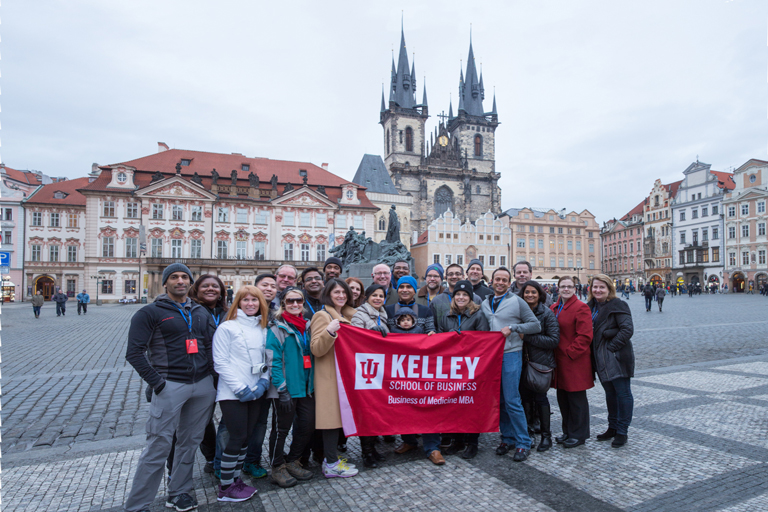When it comes to pain, there are a variety of treatment approaches that don’t always add up to the prescription of opioids.
At his new clinic, Cutting Edge Integrative Pain Centers, Dr. Orlando Landrum, MD, MBA’16, focuses on taking a deeper look at a patient’s concerns, goals and lifestyle before offering a variety of non-traditional treatments in place of – or in addition to – medication.

“One of my patients had so much ankle pain following a vascular procedure that she couldn’t do her job as a dental hygienist,” Landrum explained. “She didn’t benefit from conventional pain treatment, so we tried an integrative approach using dorsal-root spinal cord stimulation. This treatment reduced her opioids by more than 70 percent, and she returned to work.”
Before he opened his clinic in northern Indiana, Dr. Landrum was the only pain physician in a 40-member medical group that regularly debated how to better manage pain.
“We went back and forth about what should be done and couldn’t agree as physicians,” he said.
Dr. Landrum wanted to provide more options to patients – more technology and alternatives like yoga – but he found that administration resisted this path due to financial reasons.
“I asked leadership to explain to me why, but I was told that the problem might be too complex for me to understand,” remembered Dr. Landrum. “I’m typically persistent enough to learn something new, so I realized if they weren’t willing to teach me, I’d have to learn on my own. I’d recently received a flyer from the Kelley School of Business and decided to check out the Physician MBA Program.”
Dr. Landrum enrolled in the program expecting to gain a better grasp of finance and accounting.
“For instance, right now we’re looking at how to incorporate a cash-based service line into our model,” he said. “A cash-based model might also provide discounted hotels or bed and breakfasts to cater to patients traveling from out of state for care. Through my global healthcare studies course at Kelley, I saw that in the program in person, when we traveled to the Czech Republic. I’d thought it was innovative that the financial structure could support such a model. If I hadn’t had that experience, I would’ve thought it was a silly idea- but I’ve seen travel medicine at work!”

Dr. Landrum says he employs lessons from the negotiations course every day – not only as a self-employed physician, but also in deciding the approach for a patient conversation. “Some patients want to have a distributive discussion – a paternalistic, physician tells them what to do, discussion,” He said. “I learned that if I try to give that patient an integrative, win-win solution, it could alienate them. These nuances of negotiation have been incredibly useful.”
Dr. Landrum’s experience as a pain specialist was integral in group discussions during the healthcare policy course that took him and his classmates to Washington, D.C., where they learn about the creation of medical legislature. He was able to weigh in on conversations with lobbyists and attorneys about how to best address the opioid crisis as a multidimensional problem, involving everything from insurance companies to unique approaches to pain.
“It’s our jobs as physicians to determine how best to utilize unique offerings to help people in a different way, as opposed to the algorithmic approach that, thus far, hasn’t proved successful,” he said. “The business law courses led by Kelley Professor of Business Law Julie Manning Magid were phenomenal. It pushed me to reflect that I was ‘talking the talk’ about what patients need, but was I going to do something about it?”
He decided to take action.
After struggling some time with the idea of leaving the group practice to build his own integrative pain center, Dr. Landrum says his work with coach Chuck Stoner evaluating his strengths and weaknesses, interests and goals led him to open Cutting Edge Integrative Pain Centers the year after he graduated with his MBA.
“Honestly, I was afraid to go out on my own because current conventional wisdom suggests it’s smarter to be an employed physician,” he said. “But through regular discussions with my coach over the course of the program, this idea kept resurfacing. The process helped me see that I don’t fit into the conventional model, and perhaps I should consider the best fit for me. That was life-changing. I’m a much happier physician in this role, and my patients see that.”
Though he’s been on his own since 2017, Dr. Landrum acknowledges that a strength he gained during the program was collaboration. Physicians move through the program in one cohort, working together in group projects and solving problems by employing various points of view. “I can always reach out to another alum who can suggest three or four other ways to approach my problem,” he said. Dr. Landrum has incorporated this sense of collaboration in his pain clinic.
“We’re constantly looking for ways to collaborate, which is a big takeaway from my MBA,” he said. “There are different specializations of pain therapists providing online therapy, live videos of yoga, Tai chi. It affords a lot of flexibility. If a patient can’t do yoga or because insurance won’t cover it, we’ll work together to find a community class, so patients can accomplish their goals in a cost-effective way. That’s our integrative approach.”
He says physicians who recognize room for improvement in the administration of their clinical care, or those who understand healthcare can be delivered better, should consider an MBA.
“The ability to go beyond simply being a cog in the machinery of medicine and instead, direct how you want that machinery to turn, is huge,” said Dr. Landrum. “I have yet to see a physician who doesn’t think that capability would create impact in their practice and in their patient care.”
Leave a Reply